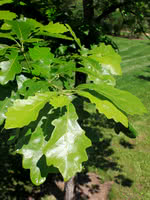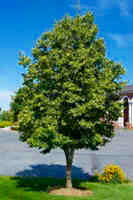Mon-Fri 9am - 5pm Mountain time
Bur Oak vs Little Leaf Linden
Quercus macrocarpa
Tilia cordata
NOT AVAILABLE THIS SEASON - MIGHT RETURN
Bur Oak has a wide distribution but is one of the only oaks that will grow well on the prairies. Bur Oak produces deeply lobed, dark green leaves that turn golden yellow to brown in the fall.
Its acorns are round and half enclosed by a mossy fringed cup.
Although slower growing, this long lived tree eventually becomes a popular large ornamental tree for driveways, parks, and the front of industrial buildings. Popular as a memorial or dedication tree.
Note: Most Oak species can be considered toxic for many animals.
Little Leaf Linden is a large, deciduous shade tree that is native to Europe. The leaves are heart shaped with fine teeth on the margins. It has much smaller leaves than Large Leaf Linden.
Its small, fragrant yellow-green flowers are said to have medicinal properties and can also be used to make honey. Little leaf Linden is a great choice for a boulevard or large lot.

